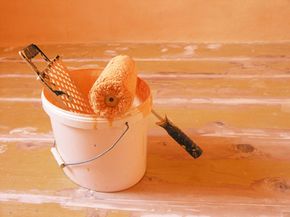The wide variety of interior paints can be bewildering -- but they exist for a reason. The trick is to be knowledgeable about their respective uses and strengths. Because there are such differences between the many paints, it's important to know about each kind.
The previews at the bottom of this page will take you to articles that explain each kind of interior paint. You'll learn which surfaces are ideal for a given paint, which tools you should use to apply them, and the advantages and disadvantages associated with each one. You'll also receive instruction on buying the right amount for the work you have to do.
Advertisement
Although interior paints are available for every possible surface, there is no such thing as an all-surface paint. The wrong paint can damage a surface and often not adhere well, so it's crucial to know in advance what goes where and when. Fortunately, modern paint technology has taken a lot of the risk out of choosing the proper paint. Formulas for so-called "latex paints" have been improved to withstand dirt, moisture, and daily wear and tear, so these paints are no longer reserved exclusively for low-traffic areas. They are as washable and durable as the old oilbase paints, so you no longer have to think in terms of latex paints for walls and oilbase enamels for woodwork, windows, and doors.
Still, an important factor in interior paint selection -- aside from personal color preference -- is gloss. Regardless of the type of coating you choose, the gloss of the one you buy will affect both its appearance and its durability. High-gloss paints are the most durable because they contain more resin than either semigloss or flat paints. Resin is an ingredient that hardens as the paint dries. The more resin, the harder the surface.
Consequently, for kitchens, bathrooms, utility rooms, doors, windows, and trim, high-gloss paints are ideal. Semigloss interior paints, with less resin and a reduced surface shine, are slightly less wear-resistant but still suitable for most woodwork. Finally, flat paints are the coatings of choice for most interior walls and ceilings because they provide an attractive, low-glare finish for surfaces that take little abuse and require only infrequent washings.
Here are previews of our articles on interior paints:
This common paint type is cheaper and easier to clean up with water.
The presence of rubber makes this paint highly durable.
To get a finish with feeling, like stucco, this paint is the right choice.
A greater amount of pigment helps you get more out of each brushful of this paint.
Ideal for painting acoustic tiles, this paint won't deaden the sound-reflecting quality of your surface.
Uneven surfaces can be smoothed out with a layer of undercoat, which is where this paint type comes in.
The room you're painting will tell you how much paint you're going to need. Learn to calculate the right amount of paint for the job at hand.
For more information on painting and on home improvement in general, see:
- Painting Interiors: Brush up on methods for painting the inside of your home.
- Exterior Paints: If you're turning your attention to the outside, see this guide to exterior paints.
- House Painting: For all things related to improving your home with paint, visit this page.
- Home Improvement: After you're done painting, learn how you can make other fixes in all parts of your home.
Advertisement
